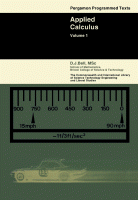Browse content
Table of contents
Actions for selected chapters
- Full text access
- Book chapterAbstract only
CHAPTER ONE - Rates of Change. Velocity. Acceleration. Area under a Curve
Pages 1-68 - Book chapterAbstract only
CHAPTER TWO - Motion with Uniform Acceleration. Angular Velocity. Mean Values. Areas and Volumes
Pages 69-135 - Book chapterAbstract only
CHAPTER THREE - Tangents and Normals. Length of Arcs. Curvature. Evolutes and Involutes. Envelopes
Pages 136-227 - Book chapterAbstract only
CHAPTER FOUR - Maxima and Minima. Points of Inflexion
Pages 228-284 - Book chapterNo access
Index
Page 285
About the book
Description
Applied Calculus, Volume 1 provides information pertinent to the fundamental principles of the calculus to problems that occur in Science and Technology. This book illustrates the use of the calculus to determine the motion of different systems, to find the areas and volumes of certain figures, and to determine the turning points on a curve. Organized into four chapters, this volume begins with an overview of the idea of the slope or gradient of a curve to derive further information from the distance-time graph. This text then examines the notation of the calculus to derive the equations of motion for a particle moving in a straight line with uniform acceleration. Other chapters consider the equation of the tangent of the curve. This book discusses as well the importance of an interval along the curve. The final chapter deals with the maximum and the minimum point on a curve. This book is a valuable resource for students.
Applied Calculus, Volume 1 provides information pertinent to the fundamental principles of the calculus to problems that occur in Science and Technology. This book illustrates the use of the calculus to determine the motion of different systems, to find the areas and volumes of certain figures, and to determine the turning points on a curve. Organized into four chapters, this volume begins with an overview of the idea of the slope or gradient of a curve to derive further information from the distance-time graph. This text then examines the notation of the calculus to derive the equations of motion for a particle moving in a straight line with uniform acceleration. Other chapters consider the equation of the tangent of the curve. This book discusses as well the importance of an interval along the curve. The final chapter deals with the maximum and the minimum point on a curve. This book is a valuable resource for students.
Details
ISBN
978-0-08-011284-8
Language
English
Published
1966
Copyright
Copyright © 1966 Elsevier Ltd. All rights reserved.
Imprint
Pergamon
